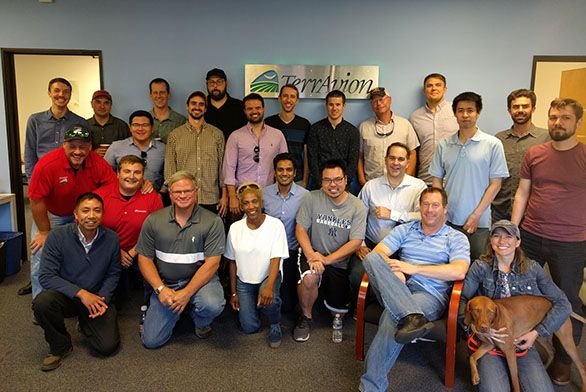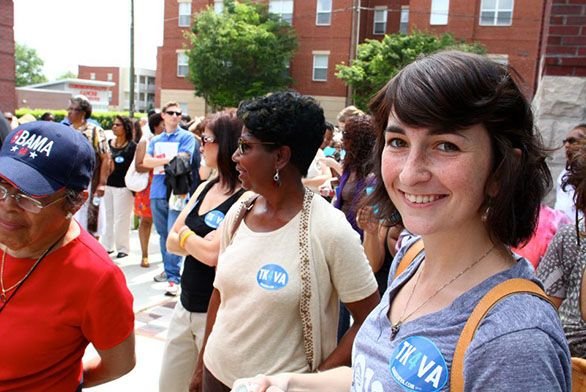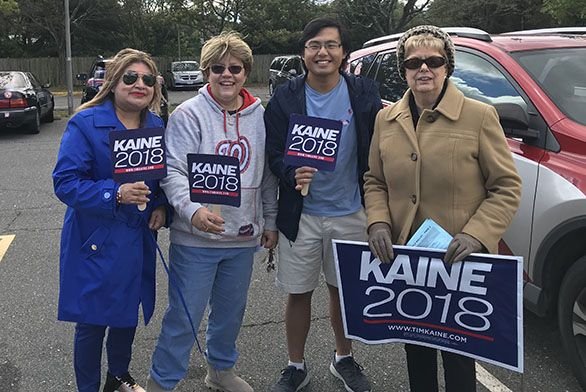Making the Most of the Alumni Network
December 13, 2018 | By Anne Kniggendorf

Robert Morris (SF04) and Amariah Fuller (SF11) ran into each other on the steps of the San Francisco State House in 2013. The two recognized each other from a St. John’s College Alumni Association Meeting and got to talking.
Morris had just started a venture-backed technology company called TerrAvion that creates agricultural aerial imagery. He’d been trying to build an equipment shed on his own and realized he really needed a hand.
Fuller had just returned from teaching abroad and was looking for work.
When he agreed to build Morris’ equipment shed, he became TerrAvion’s first employee. Five years later, he’s the head of products for the company and manages the engineering team.
While Morris has hired other employees since, Fuller’s unique Johnnie skill set still sets him apart.
“That mentality is really valuable. You can usually employ people to show up and do things for you, but to own a problem and to fix the unknown things, that is something that Johnnies, if they’re motivated, are really good at,” Morris says.
If he wants an engineer, he’ll hire an engineer. And if he wants a salesperson, that’s who he’ll hire. But he’s willing to take a chance on fellow St. John’s alumni for other positions, he says, because of the critical thinking cultivated by the program.
“I have a lot of problems where I need a smart person to figure [it] out and go fix it: how to do customer support, how to administer the business, how to do some of our operations stuff that nobody knows how to do.”
Morris and Fuller’s business relationship arose organically, but others take a more deliberate approach when it comes to alumni networking.
Kevin Lam (A18), for example, connected with Megan Field (A10) through the college’s career services office. Though he contacted the Annapolis office, both campuses are happy to help.
“I do work individually with alumni when they contact our office,” says Jay Woodward, alumni engagement officer in the Santa Fe Office of Personal and Professional Development. “What we’re doing right now is a very individualized assistance, tailored to [the Johnnie’s] unique circumstances and their desires and needs. If you’re looking to branch out and feel what kind of support our office may offer, or if you’re looking for resources for graduate school or professionally, I’m a contact point and we welcome you with open arms.”
Lam knew he wanted to go into politics. He’d already interned at the Maryland State House and for a nonprofit that advocates for Asian-American workers through the Hodson Trust Internship Program, and he was excited to reach out to Field, who he knew had worked for Senator Tim Kaine before leaving for Harvard Law School (where she’s now in her third year). She said Lam’s emails immediately made a favorable impression; they were thoughtfully written, showed that he was self-motivated, and his networking-related requests were respectful of her time and resources.
“He had all of the Johnnie qualities that make me immediately connect to other Johnnies,” she says. “He was a really good listener, he was inquisitive, he was sort of intellectually self-confident without being arrogant ... so, the best parts of St. John’s.”
After getting to know Lam, Field felt comfortable connecting him with Senator Kaine’s campaign manager and field director. Now, Lam is a field organizer just as Field was when she started in politics in 2012.

Lam, in fact, had an advantage that Field had not—he had begun thinking about his career options early. Field says that her biggest handicap after graduation was that she had sunk into what she calls “the bubble,” meaning that she’d let the outside world go and become consumed by the Program, as many do. When she began her career, then, she didn’t recognize even prominent political figures because she hadn’t watched television at all during her four years of undergrad.
She says that Lam managed to fully immerse himself in the Program while still keeping one foot in the real world.
“I think that people wait too long to start talking to people about their career interests. It’s a real privilege to not think about it for a while, but it can also be fun to explore careers in a Johnnie-esque way,” Field says. “Kevin was a full year from graduation and knew a little bit about the field, but our first conversation was sort of all over the place.”
Still, that allowed Lam’s plans to shift and change the more he learned. Such early conversations about his career helped him seekers avoid putting time and energy into chasing a dream he would not eventually want to pursue.
Such was the case for Connor McCourt (A17), who began reaching out to alumni in the midst of an unsettling transition from Program life to the ‘real world.’
“There are a number of tools alumni can use” to network, says Jaime Dunn, director of Career Services on the Annapolis campus, but “the hardest part is starting.”
“Something we’ve seen a lot lately is the rise of LinkedIn,” she says. “Once you’re on LinkedIn, a lot will happen naturally—it’ll suggest people to connect with, and people will start connecting with you. Its platform is so powerful, and you can find Johnnies a lot of different ways—Johnnies in medicine, Johnnies in DC, Johnnies in law.”
These specialized connections can also be found through Facebook affinity groups listed on the alumni office’s web page, as there are likely to be people on the social network that aren’t on LinkedIn. (The Alumni Association will be sending out a networking packet to Alumni Chapters with networking resources and guides for hosting networking events.) It may seem overwhelming, but Dunn recommends approaching the process using small steps—reaching out to just one or two people to start.
After graduation, McCourt reached out to several alumni, including fellow New Jersey Johnnie Adrian Trevisan (A84). McCourt says that he had a 100% response rate from those he contacted for help and advice.
“It was comforting to know that there’s this sort of fraternity as well as this family of Johnnies, that really supersedes all time,” he says. “I felt that warmth and empathy with each person I talked to.”
This is particularly true of SJC Connect, St. John’s private network that functions a bit like a mashup of Facebook and LinkedIn. Though the network is smaller than that of LinkedIn, members can mark themselves ‘willing to help,’ making it easy to identify who is happy to discuss career options and serve as a resource.
“If you’re really intimidated or uncomfortable as you start the process,” Dunn says, “that’s a guaranteed way to know that someone who has signed up on the platform is ready and willing to be contacted.’”
Trevisan acted as McCourt’s unofficial point of contact with the world of working St. John’s College alumni. The two had lunch and discussed McCourt’s career options.

While McCourt had had internships and done work for his father, which he says gave him an “unofficial MBA,” he had a strong interest in writing. Initially, he thought he’d like to pursue a career in journalism—but after talking to Trevisan and a Johnnie journalist in Washington, DC who Trevisan connected him with, he decided journalism wouldn’t be a great fit after all.
McCourt says those initial conversations were invaluable to him and urges alumni to draw on the St. John’s education rather than think that they must start from scratch because they were not trained in a vocation. Perhaps most importantly, he encourages students and graduates to take advantage of the Johnnie network.
“My path was opened up by those conversations. My direction and approach to getting a job were directed by real-world experience and by practical life after St. John’s,” he says. “I think being able to recognize that there’s always an open conversation that the network is going to have and that people are going to offer you should be encouraging. It’s a support system as well as a catalyst for you to find your own way and blaze your own trail.”
He eventually found a Sales Development Representative position at a company called Contently in New York City, which combines his interests in writing and business.
The key, he says, is to translate the St. John’s education into applicable job market skills, just as the college translates official student transcripts into language other universities will respond to.
“How does the St. John’s education create value for you, and how are you going to create value for an organization through the education that you received?” he asks. “I think that’s the first opening question to [begin] understanding what job and vocation you’re looking to go after.”

